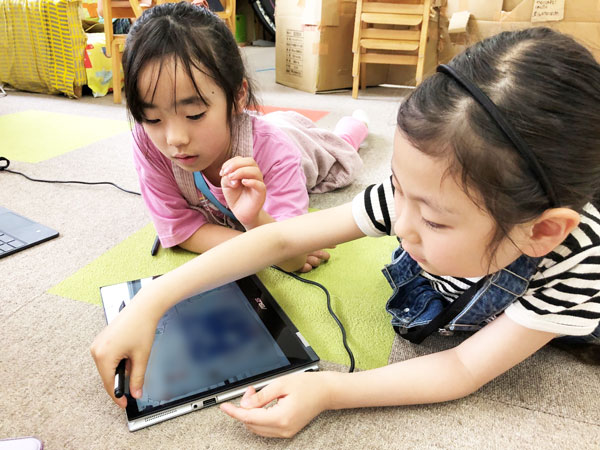"My child can't sit still in a chair. I don't know what to do."
This is a matter of concern that is often brought up by parents of a child attending school. These include the child getting up and walking around during class, not sitting up straight, repeatedly pulling chairs closer to the table, etc. There are differences in the extent to which the behavior is problematic, and candid advice is usually provided by the class teacher.
In contrast, students who sit up straight in class and pay attention without making the slightest move are praised and recognized as model students.
Adults are apt to tell children "Sit up straight and keep still!" However, children who are unable to do so also have something to say. The class is too easy and boring or too difficult and boring, or they want to be near their friends, or there is something that bothers them. It is rather hard for such reasons to be understood and accepted. Regardless of their individual traits and penchants, it is natural for children to be constantly moving about. On the contrary, there is reason to worry if they keep still.
So, why do schoolteachers want children to stay seated? Some people might answer "It is impolite to be moving about when listening to someone talking!" Certainly, it is disturbing if students are moving about while you are talking, and this may have a negative effect on motivation to continue the class. Not observing good manners is rude—that feeling is also understandable. However, what is considered "good manners" in this case can also be a burden or something troublesome.
Take, for example, what we have been told since we were children: "Sit still and listen to what the other person is saying." It is, so to speak, acquired behavior that is based on rules that make up our culture. To a large extent, much of the pleasure or displeasure that we feel may originate from what we have been taught by others. When students get up and start walking around and do not listen when I am teaching, or various happenings occur in class, I feel pleasantness or unpleasantness in my mind, something like a spinal reflex. But considering this logically, most of the time, my own pleasant or unpleasant responses do not necessarily seem right.
For example, if there is a student with muscular dystrophy or another condition who is unable to sit in a chair in the classroom, will that child forfeit the right to learn? Of course not. So, is it then OK for everyone to lie down during class? That would certainly not be the case either. Based on the view "that child is special," we provide such treatment, and as a result, it seems that the gap remains and never closes.
Nevertheless, there also appear to be functional problems. For example, there is the problem of other children being unable to maintain concentration due to interference. It is true that they become easily distracted when they are intently listening, and other children cut across their field of vision or jump around in the corner of their eye.
However, this also seems to vary widely depending on the environment. When chairs are lined up and everyone must be seated facing the same direction, children who run around will definitely appear to be "bad kids who disturb everyone's concentration."
On the other hand, in public places like the library, there are people actually walking around, but it is not particularly disturbing. When studying in a coffee shop or a family restaurant, the other customers will not be disturbing to such an extent. In any case, it appears that the effect of the environment is large.
In school classrooms as well, it would be good to arrange desks in a variety of ways. In nearly all Japanese schools, everyone is lined up and situated so that they face the same blackboard. In other countries, seating tends to be arranged in a meeting style, that is, in the shape of a square with four sides or one with three sides and one side open.
Concentration even differs according to the individual. Some children are capable of sustained concentration even if there is something slightly distracting in their field of vision while others are disturbed by just the slightest noise. Maintaining concentration can also differ depending on who occupies the adjacent seat.
In most cases today, the classroom seating arrangement is decided by the teacher or by drawing names. However, in my view, the truly best environment for concentrating is one that you choose yourself. Can you concentrate when sitting at the front of the classroom or when seated next to the wall? Or do you move around, so is it better to sit in the back of the classroom? Try it, and if it doesn't work well, change. We should provide more leeway and capacity for flexible self-adjustment in the classroom.
Looking at this from a different perspective, I think it is also necessary to change the lesson style that requires 45-50 minutes of instruction and explanation from the teacher. Today, students each have a tablet in class. Even if the steps and methods involved in learning are not the words of the teacher, there are various ways to learn.
When I was teaching at a public school, I let the students move their desks wherever they liked whenever we had class. There were students who moved near friends, some who positioned their desk facing the wall, and others who made groups. They each chose a place that would be good and easy for them to concentrate. The teacher would speak for about one-third of the class time after which the students would then study on their own. There were quite a number of students in this grade who were rather restless, so even if there were students walking around, this was not considered a particular problem in this class style. At HILLOCK Primary School where I currently work, the floor is carpeted, so there are children who lie on the floor while studying.

Many visitors are startled to see this, but today we live in an age when employees at large companies work with portable computers while standing and some authors write novels while lying down. Considering this in terms of the ability to concentrate, it does not necessarily appear bad. The children are not necessarily lying sprawled out. They sometimes sit on chairs or on the floor Japanese-style and appear to maintain concentration by changing posture.
When someone is speaking before a group, it is commonly understood that one should not disturb the focused attention of those in the audience. For that reason, children who find it difficult to concentrate will come to the front, and children who want to listen while squeezing or touching something will do so without others noticing and those who want to listen while moving around can sit in the back. If they feel like making noise, it is OK to leave the room. When they cannot concentrate, it is possible for them to express this difficulty and do so.
To begin with, good manners involve being considerate of others. Activity that is practiced and conducted with no consideration of others—can this activity be called good manners? It would be activity and behavior in favor of a certain person only.
When there is a child who cannot stay seated in the classroom, rather than exploiting the child who cannot sit still by forcing responsibility and continued effort, consider designing an environment that would not present a problem even if someone cannot remain seated. By doing so, I would like to reconsider what we adults ‟take for granted."















